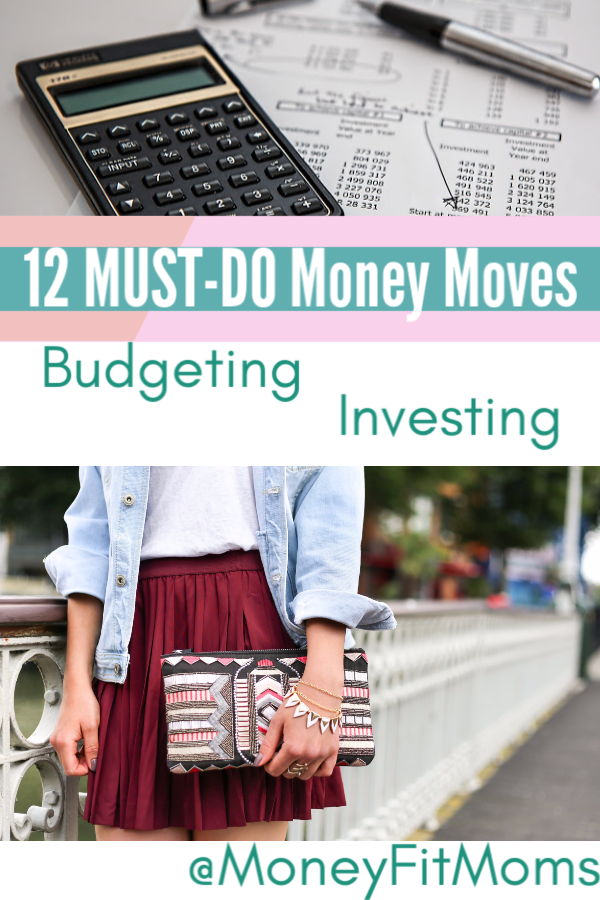Personal finance has three main areas, so covering all these bases will brighten your financial future (1) Cash management (e.g. budgeting), (2) Wealth creation (e.g. investing and retirement), and (3) Asset protection (e.g. insurance, will & trust).
I’ve compiled a list of what I consider to be the 12 most critical, must-do personal finance “money moves” you can make to secure your financial future. (To receive a printable to-do checklist of these items, subscribe to our monthly budget reminder).


CASH MANAGEMENT aka Budgeting
1. MONTHLY BUDGET
Money Fit Move #1: Update your budget monthly during your Monthly Money Meeting to analyze your expenses and ensure you are living within your means. Know your “burn rate” (how much you spend in an average month).
Budgeting is essential for two reasons:
(1) Planning.
Planning for the future (e.g. retirement, home-buying, paying down debt, etc.) requires you to have a clue about your income and expenses. Keeping a budget is a great way to plan for future large expenses (cars, furniture, tuition) without having to finance those purchases with debt (credit cards, loans, store financing, etc.).
If you’re living within your means, do you need to be budgeting?
Not necessarily, although you still need to know your yearly “burn rate” or lifestyle spending for retirement planning purposes. If you refuse to budget, you could plan for future large purchases by setting money aside in a different savings account. But budgeting is still more powerful. Tracking your spending and planning for future expenses will allow you to more confidently give generously to charity and make meaningful purchases, such as a priceless family vacation without the associated financial stress.
(2) Awareness & Accountability.
Keeping a food diary naturally causes us to lower our calories and keeping a budget lowers our expenses and saves money. Why? Awareness and accountability. Knowing you’ll be accountable for that donut or impulse buy naturally causes us to think twice.
My favorite budgeting tool:
I’ve used Mint, EveryDollar, and Quicken. The budgeting tool I recommend is YNAB (You Need A Budget)–affiliate link. YNAB is not free and has a learning curve (free app: Mint); however, in my experience, nothing beats YNAB’s ability to plan for future large purchases (e.g. new car, vacation, home). YNAB also has great customer service (a real human responds to all your questions via email and will continue to follow-up until you’re satisfied), so you won’t be on your own.
Want a reminder to update your budget every month? Signup for a free monthly reminder.
2. DEBT-FREE (goes faster if you’re budgeting!)
Money Fit Move #2: Pay off all your debts (besides your mortgage–should you pay off your mortgage early?).
Interest should be earned, not paid.
Make a list of your debts, decide that your lifestyle is going to change for a while, and start attacking those debts, one by one, like a ninja. It will be rough for a couple of months while you adjust to your new lifestyle, but as those debts get crossed off, you will feel AMAZING.
Get a debt snowball going, meaning you should attack your smallest debt first. Those small wins will give you momentum. If you need daily motivation to pay down your debts, I recommend joining a Facebook group or listening to a podcast dedicated to becoming debt-free.
3. TAX PLANNING
Money Fit Move #3: File your tax returns on time. Consult a reliable source to prepare or review your returns and use every prudent technique to legally minimize your taxes.
Should you hire someone to prepare your taxes?
It depends on how complicated your tax return is. If you have a couple of W-2s and a few standard deductions (e.g. a mortgage, property taxes, charitable deductions, etc.), you might be okay using do-it-yourself online software. If you’re not sure you understand your taxes, don’t hesitate to hire a professional. Ask your friends for a local CPA they trust. If you try to do-it-yourself, you may be saving pennies to lose a dollar. Let me put it this way: I have a masters of accountancy with an emphasis in tax and I don’t even prepare my own taxes anymore. I used to, but once our investments and income got complicated enough, I took my own advice and hired someone who deals with our tax issues day-in and day-out.
What’s the best do-it-yourself online tax software?
Here’s my breakdown of the best tax software.
4. EMERGENCY FUND
Money Fit Move #4: Save 3-6 months of expenses for a rainy day.
Would you believe that 63% of Americans don’t have enough savings to cover a $500 emergency expense? It’s true. Large unexpected expenses such as medical bills, job loss, and other financial emergencies are unfortunately a part of life. If you wait for bad things to happen to start saving, it’s too late. An emergency fund is not an asset, it’s insurance.
How big should my emergency fund be?
3-6 months’ worth of expenses (aka your “burn rate” x 3-6 m. The most common reason to dip into your emergency fund is job loss and medical emergencies, so it depends on what type of job you have. If you’re in a specialized or higher-paying field where there are fewer positions, I’d aim for having an emergency fund wroth ~6 months of expenses.
5. SAVE FOR LARGE EXPENSES
Money Fit Move #5: Plan for upcoming large expenses during your Monthly Money Meeting (if you have a partner, include them).
Large expenses are inevitable. Cars break down. Laptops quit. If you want to buy a home, you’ll need a down payment. Property tax and insurance payments come due. Rather than waiting for these expenses to pop up and hoping you have the money, make your best guess for the amount and timing of the expenses and start saving now. These savings are on top of your emergency fund. Your emergency fund is for just that: emergencies.
Example #1: Let’s imagine your minivan is on its last leg (mine actually is). You don’t know when it’ll die but you know a relatively new one (yet still used van, which I recommend) will cost $40,000. Rather than giving up and deciding you’ll get a car loan for the full amount, start saving as aggressively as you can. One of three things will happen: (1) You’ll be able to save the full amount–woohoo! (2) You’ll fall short and end up needing to get an older model than planned. (3) Even if you end up deciding to get a car loan, you’ll be able to pay down the loan much faster (which you should), saving you money!
Example #2: Let’s say you’re budgeting for new furniture that costs $2,000. If you save $200/month, in 10 months, you can buy that couch without accruing any debt.
p.s. If you can handle a little humor on this topic, this SNL skit with Amy Poehler and Steve Martin hits the nail right on the head.


INVESTING & RETIREMENT (aka WEALTH CREATION)
6. RETIREMENT MILESTONES
Money Fit Move #6: Calculate your retirement savings milestones.
I’m going to share my favorite article ever written about retirement. Do you remember playing Oregon Trail? Remember trying to arrive at your destination before winter set in? That’s just like saving for retirement. In both Oregon Trail and retirement, milestones along the way help you figure out if you’re on track to arrive on time. As the author David John Marotta states, “Fall too far behind, and you risk not being able to save enough to catch up.”
The goal is to start saving for retirement at age 25 and save ~15% of your lifestyle spending every year. If you’re behind, consider saving more aggressively to catch up to the milestones and arrive at retirement by age 65. If you want to have FIRE (Financial Independence, Retire Early), you will also need to invest more aggressively–consult a financial advisor or CPA.
Here are the retirement savings milestones, according to this Forbes article:
Note: 1 year = 1 year’s worth of lifestyle spending (expenses aka monthly burn rate–a number you know from doing Money Fit Move #1–Budgeting)
| Age 25: | 0 years saved |
| Age 31: | 1 year saved |
| Age 35: | 2 years saved |
| Age 41: | 4 years saved |
| Age 46: | 6 years saved |
| Age 51: | 9 years saved |
| Age 55: | 12 years saved |
| Age 61: | 17 years saved |
| Age 65: | 23 years saved |
| Age 70: | Should be able to live off of a safe withdrawal rate |
7. ON TRACK FOR RETIREMENT
Money Fit Move #7: Get on track for my retirement savings milestones (~15% of your income, depending on when your start and when you want to retire)
Because knowledge is half the battle, you can check off Money Fit Move #6 as soon as you’ve calculated your annual lifestyle spending and applied it to your retirement milestones. This item #7 is checked off when you actually get on track to meet your retirement milestones. The sooner you get on track, the more you can take advantage of the time value of money and let your investments do the work for you.
8. INVESTED
Money Fit Move #8: Take advantage of the time value of money by growing your retirement savings in goal-appropriate, diversified and secured investment accounts, working with a financial advisor when necessary.
Have you heard about “the millionaire next door”: The tale of someone who received a modest monthly paycheck who nonetheless achieved financial freedom and retired comfortably? My grandparents are such an example. Most people hear that tale and assume a happy ending was achieved through scrimping and saving. The truth is that the money set aside for savings would most likely not have been enough for retirement without being properly invested in the market (through retirement accounts and other diversified investment vehicles).
Why is investing important? Isn’t saving enough?
Savings should not be shoved under a mattress. Once you have an emergency fund (3-6 months of expenses held in cash to pay for those inevitable rainy days), those savings are seeds that should be grown through investing. I’m not talking about investing in single “hot stocks” or your brother-in-law’s gimmicky business idea. I’m talking about boring, inexpensive, yet relatively safe and diversified investments like mutual funds that may fluctuate in the short term, but grow over the long-term exponentially faster than your cash will when sitting in a bank account, losing money because the meager interest it loses won’t even outpace inflation.


ASSET PROTECTION
9. HEALTH INSURANCE
Money Fit Move #9: Have sufficient health insurance coverage
This one seems obvious enough, but did you know the majority of bankruptcies are related to medical issues? To explain, these bankruptcies are due to high medical bills and the loss of the ailing bread-winners income, which brings me to my next point . . .
10. DISABILITY INSURANCE
Money Fit Move #10: Figure out how many disability benefits you (and your spouse qualify for). If insufficient to replace your income, get disability insurance.
You will likely need it
Most people emphasize life insurance which only pays out in the event of death. Families are significantly more likely to be financially affected by disability than death. The Social Security Administration predicts over 1 in 4 adults will be disabled at some point before age 65. Some workers will qualify for disability benefits from social security. However, the average in 2019 was only a little over $1,000/month—not enough to replace most people’s income. Five states (CA, HI, NJ, NY, RI) provide some disability benefits, but only for the short-term. If you are dependent on someone’s income (including yourself), I would recommend buying supplemental disability insurance.
Where can I get disability insurance? We shopped around on our own. Now there are cool providers like Policy Genius that allow you to compare different policies.
11. LIFE INSURANCE
Money Fit Move #11: If someone is dependent on your income (or if you are dependent on someone else’s), calculate how much life insurance you need and get it.
How much life insurance do I need? Use the second calculator on this page to figure it out.
Should I use life insurance as an investment vehicle? I’m not usually a yeller, but . . . NO! That’s what actual investments are for. Get term life insurance. It’s cheap and effective.
Where can I get life insurance? Once again, had Policy Genius existed when my husband and I were shopping around for term life insurance, that is what I would have used.
Lastly,
12. LEGAL WILL
Money Fit Move #12: Make a will to ensure your assets and dependents (e.g. children) will go where you want them to. If desired, I create a trust to avoid probate (and its associated time and legal fees).
How do I create a will? Consult a local trusted lawyer or use an online service like LegalZoom. Creating a will with them starts at about $89. Feel like you can’t afford it? Time to start budgeting! You’ll find expenses you can skip to make room for expenses that really pay off, like creating a will.
In Conclusion
So, those are the 12 most important Money Fit Moves! Overwhelmed much? Don’t be. Rome wasn’t built in a day and neither will your financial future. Sign up for my monthly budgeting reminder emails (and follow me on Instagram) and I’ll help you work towards these goals, one at a time until you’ve accomplished them all (and celebrated with a DANCE PARTY 

